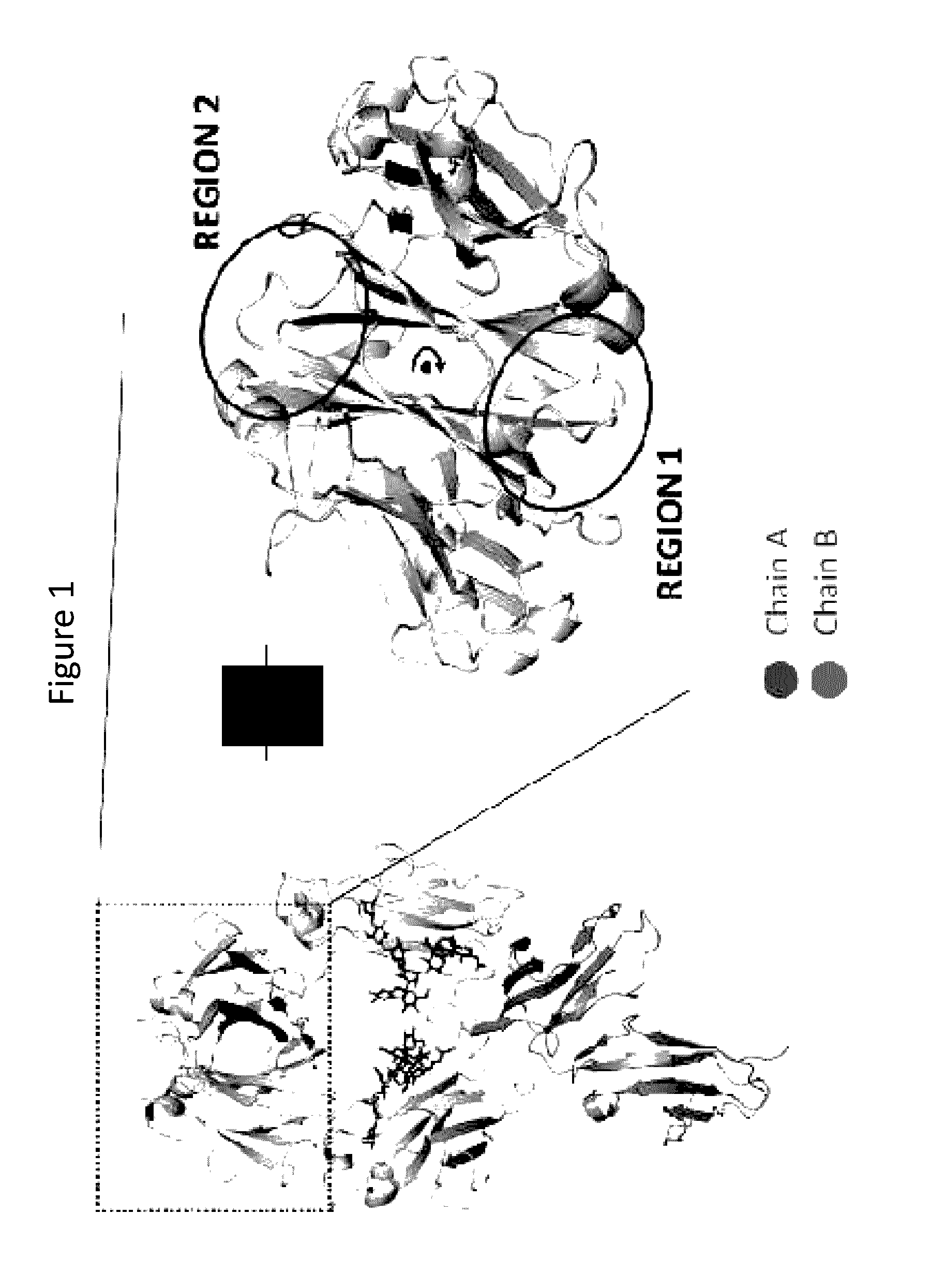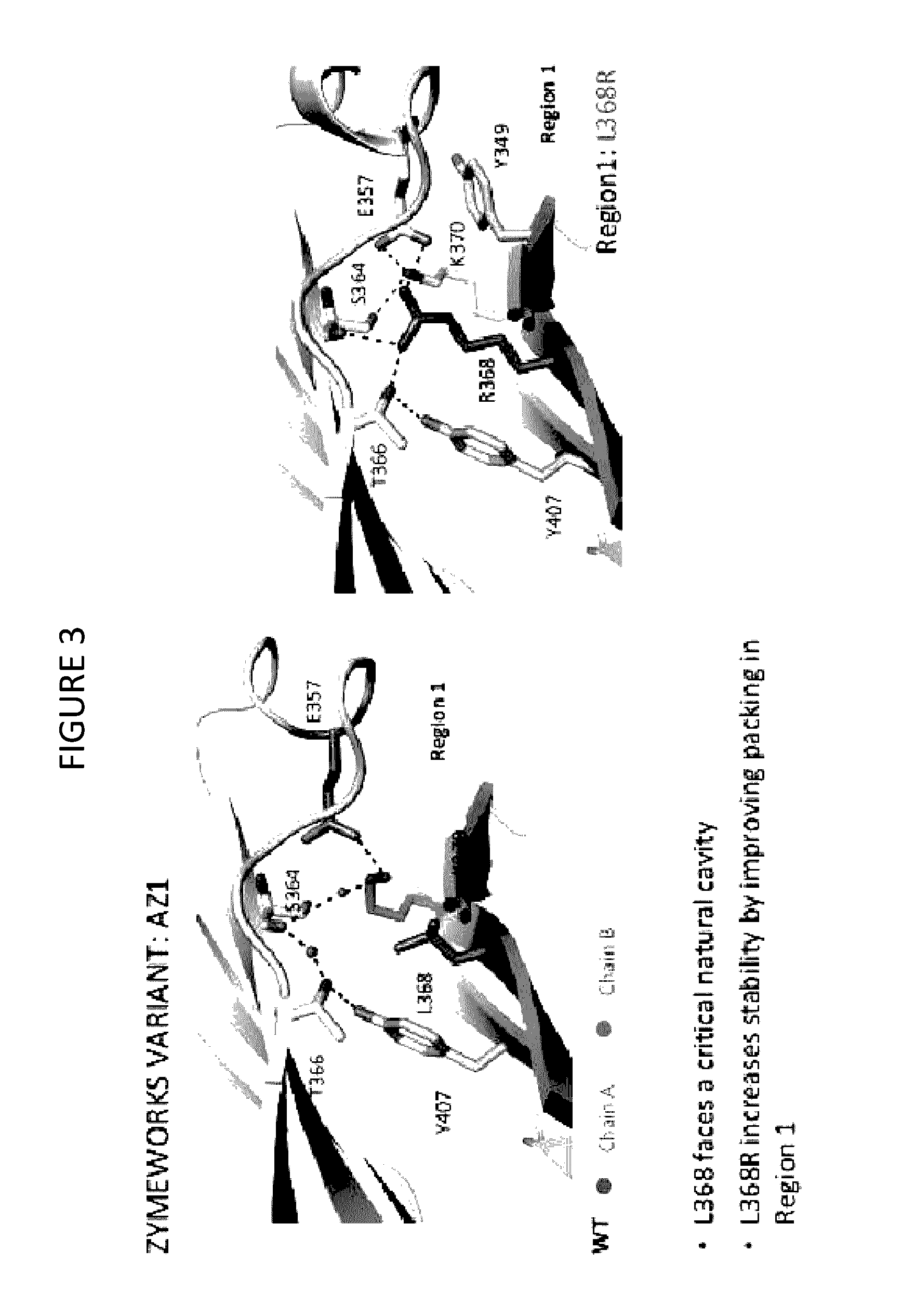Stable heterodimeric antibody design with mutations in the Fc domain
a heterodimer and domain technology, applied in the field of polypeptide heterodimers, can solve the problems of difficult production of bispecific antibody molecules with the two fab arms selected to bind two different targets using traditional hybridoma techniques, and achieve the effect of increasing stability and encouraging heterodimer formation
- Summary
- Abstract
- Description
- Claims
- Application Information
AI Technical Summary
Benefits of technology
Problems solved by technology
Method used
Image
Examples
example 1
Generation of Bivalent Monospecific Antibodies with Heterodimer Fc Domains
[0279]The genes encoding the antibody heavy and light chains were constructed via gene synthesis using codons optimized for human / mammalian expression. The Fab sequences were generated from a known Her2 / neu binding Ab (Carter P. et al. (1992) Humanization of an anti P185 Her2 antibody for human cancer therapy. Proc Natl Acad Sci 89, 4285.) and the Fc was an IgG1 isotype (SEQ ID NO:1). The final gene products were sub-cloned into the mammalian expression vector pTT5 (NRC-BRI, Canada) (Durocher, Y., Perret, S. & Kamen, A. High-level and high-throughput recombinant protein production by transient transfection of suspension-growing human HEK293-EBNA1 cells. Nucleic acids research 30, E9 (2002)). The mutations in the CH3 domain were introduced via site-directed mutagenesis of the pTT5 template vectors. See Table 1 and Table 6 and Table 7 for a list of the variant CH3 domain mutations made.
[0280]In order to estimate...
example 2
Purification of Bivalent Monospecific Antibodies with Heterodimer Fc Domains
[0284]The clarified culture medium was loaded onto a MabSelect SuRe (GE Healthcare) protein-A column and washed with 10 column volumes of PBS buffer at pH 7.2. The antibody was eluted with 10 column volumes of citrate buffer at pH 3.6 with the pooled fractions containing the antibody neutralized with TRIS at pH 11. The protein was finally desalted using an Econo-Pac 10DG column (Bio-Rad). The C-terminal mRFP tag on the heavy chain B was removed by incubating the antibody with enterokinase (NEB) at a ratio of 1:10,000 overnight in PBS at 25° C. The antibody was purified from the mixture by gel filtration. For gel filtration, 3.5 mg of the antibody mixture was concentrated to 1.5 mL and loaded onto a Sephadex 200 HiLoad 16 / 600 200 pg column (GE Healthcare) via an AKTA Express FPLC at a flow-rate of 1 mL / min. PBS buffer at pH 7.4 was used at a flow-rate of 1 mL / min. Fractions corresponding to the purified antib...
example 3
Stability Determination of Bivalent Monospecific Antibodies with Heterodimer Fc Domains Using Differential Scanning Calorimetry (DSC)
[0286]All DSC experiments were carried out using a GE VP-Capillary instrument. The proteins were buffer-exchanged into PBS (pH 7.4) and diluted to 0.4 to 0.5 mg / mL with 0.137 mL loaded into the sample cell and measured with a scan rate of 1° C. / min from 20 to 100° C. Data was analyzed using the Origin software (GE Healthcare) with the PBS buffer background subtracted. (See, FIG. 27). See Table 3 for a list of variants tested and a melting temperature determined. See Table 4 for a list of the variants with a melting temperature of 70° C. and above and the specific Tm for each variant.
[0287]
TABLE 3Melting temperature measurements of variant CH3 domains in anIgG1 antibody having 90% or more heterodimer formationcompared to homodimer formationVariantTm ° C.Wild-Type81Control 169Control 269AZ365AZ668AZ868AZ1277AZ1477AZ1571.5AZ1668.5AZ1771AZ1869.5AZ1970.5AZ2...
PUM
| Property | Measurement | Unit |
|---|---|---|
| Tm | aaaaa | aaaaa |
| Tm | aaaaa | aaaaa |
| Tm | aaaaa | aaaaa |
Abstract
Description
Claims
Application Information
 Login to View More
Login to View More - R&D
- Intellectual Property
- Life Sciences
- Materials
- Tech Scout
- Unparalleled Data Quality
- Higher Quality Content
- 60% Fewer Hallucinations
Browse by: Latest US Patents, China's latest patents, Technical Efficacy Thesaurus, Application Domain, Technology Topic, Popular Technical Reports.
© 2025 PatSnap. All rights reserved.Legal|Privacy policy|Modern Slavery Act Transparency Statement|Sitemap|About US| Contact US: help@patsnap.com



